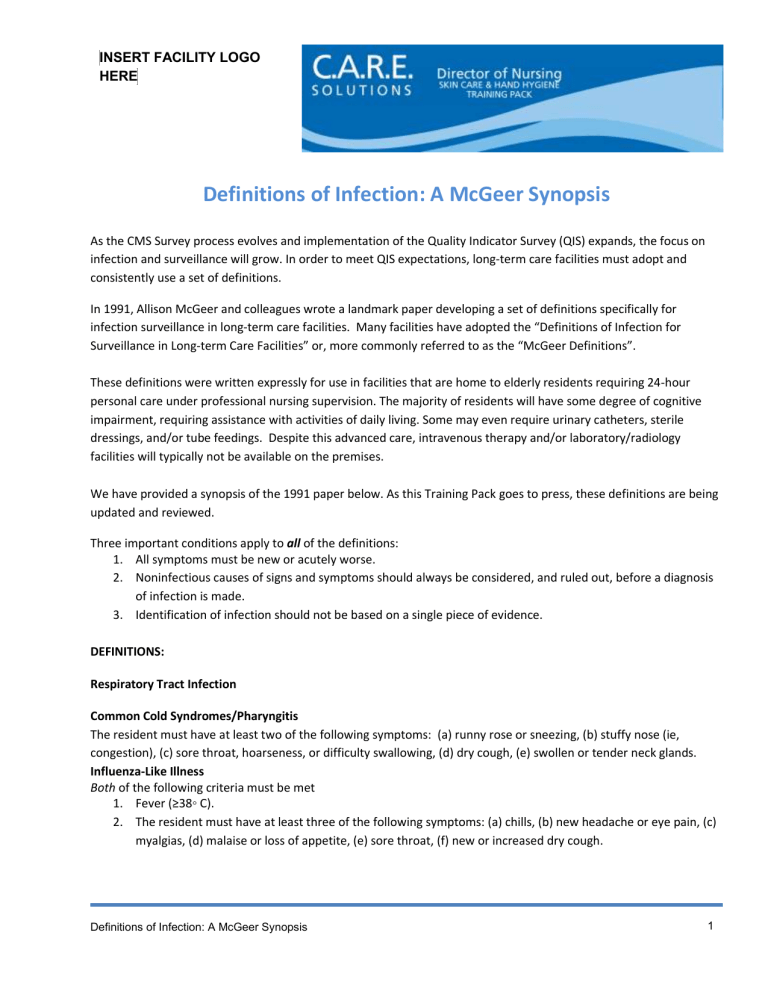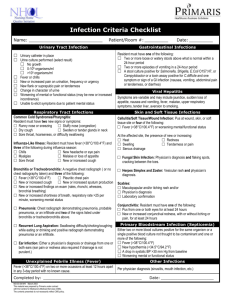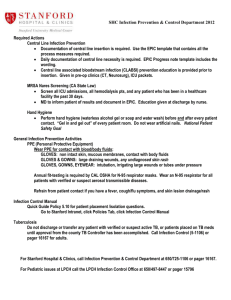A Summary of “Definitions of Infections for Surveillance in Long

INSERT FACILITY LOGO
HERE
Definitions of Infection: A McGeer Synopsis
As the CMS Survey process evolves and implementation of the Quality Indicator Survey (QIS) expands, the focus on infection and surveillance will grow. In order to meet QIS expectations, long-term care facilities must adopt and consistently use a set of definitions.
In 1991, Allison McGeer and colleagues wrote a landmark paper developing a set of definitions specifically for infection surveillance in long-term care facilities. Many facilities have adopted the “Definitions of Infection for
Surveillance in Long-term Care Facilities” or, more commonly referred to as the “McGeer Definitions”.
These definitions were written expressly for use in facilities that are home to elderly residents requiring 24-hour personal care under professional nursing supervision. The majority of residents will have some degree of cognitive impairment, requiring assistance with activities of daily living. Some may even require urinary catheters, sterile dressings, and/or tube feedings. Despite this advanced care, intravenous therapy and/or laboratory/radiology facilities will typically not be available on the premises.
We have provided a synopsis of the 1991 paper below. As this Training Pack goes to press, these definitions are being updated and reviewed.
Three important conditions apply to all of the definitions:
1.
All symptoms must be new or acutely worse.
2.
Noninfectious causes of signs and symptoms should always be considered, and ruled out, before a diagnosis of infection is made.
3.
Identification of infection should not be based on a single piece of evidence.
DEFINITIONS:
Respiratory Tract Infection
Common Cold Syndromes/Pharyngitis
The resident must have at least two of the following symptoms: (a) runny rose or sneezing, (b) stuffy nose (ie, congestion), (c) sore throat, hoarseness, or difficulty swallowing, (d) dry cough, (e) swollen or tender neck glands.
Influenza-Like Illness
Both of the following criteria must be met
1.
Fever (≥38 ◦ C).
2.
The resident must have at least three of the following symptoms: (a) chills, (b) new headache or eye pain, (c) myalgias, (d) malaise or loss of appetite, (e) sore throat, (f) new or increased dry cough.
Definitions of Infection: A McGeer Synopsis 1
Pneumonia
Both of the following criteria must be met:
1.
Interpretation of a chest radiograph as demonstrating pneumonia, probable pneumonia, or the presence of an infiltrate. If a previous radiograph exists for comparison, the infiltrate should be new.
2.
The resident must have at least two symptoms described under “other lower respiratory tract infections”.
Noninfectious causes of symptoms must be ruled out. In particular, congestive heart failure may produce symptoms and signs similar to those of respiratory infections.
Other Lower Respiratory Tract Infection (bronchitis, tracheobronchitis)
The resident must have at least three of the following symptoms: (a) new or increased cough, (b) new or increased sputum production, (c) fever (≥38 ◦ C), (d) pleuritic chest pain, (e) new or increased physical findings on chest examinations (rales, rhonchi, wheezes, bronchial breathing), (f) one of the following indications of change in status or breathing difficulty: new/increased shortness of breath or respiratory rate >25 per minute or worsening mental or functioning status.
Symptomatic Urinary Tract Infection
One of the following criteria must be met:
1.
The resident does not have an indwelling urinary catheter and has least three of the following symptoms: (a) fever (≥38 ◦ C) or chills, (b) new or increased frequency, urgency, or burning pain on urination, (c) new flank or suprapubic pain or tenderness, (d) change in character of urine, (e) worsening of mental or functional status.
2.
The resident has an indwelling catheter and has at least two of the following symptoms: (a) fever (≥38 ◦ C) or chills, (b) new flank or suprapubic pain or tenderness, (c) change in character of urine, (d) worsening of mental or functional status.
Eye, Ear, Nose, and Mouth Infection
Conjunctivitis
One of the following criteria must be met:
1.
Pus appearing from one or both eyes, present for at least 24 hours.
2.
New or increased conjunctival redness, with or without itching or pain, present for at least 24 hours (also known as “pink eye”).
Symptoms must not be due to allergy or trauma to the conjunctiva.
Ear Infection
One of the following criteria must be met:
1.
Diagnosis by a physician of any ear infection.
2.
New drainage from one or both ears. (Non-purulent drainage must be accompanied by additional symptoms, such as ear pain or redness.)
Mouth and perioral infection:
Oral and perioral infections, including oral candidiasis, must be diagnosed by a physician or a dentist.
Sinusitis
The diagnosis of sinusitis must be made by a physician.
Skin Infection
Cellulitis/soft tissue/wound infection
One of the following criteria must be met:
1.
Pus present at a wound, skin, or soft tissue site.
2.
The resident must have four or more of the symptoms: (a) fever (≥38 ◦ C) or worsening mental/functional status; and/or, at the affected site, the presence of new or increasing (b) heat, (c) redness, (d) swelling, (e) tenderness or pain, (f) serous drainage.
Definitions of Infection: A McGeer Synopsis 2
Fungal skin infection
The resident must have both (a) a maculopapular rash and (b) either physician diagnosis or laboratory confirmation.
Herpes simplex and herpes zoster infection
For a diagnosis of cold sores or shingles, the resident must have both (a) a vesicular rash and (b) either physician diagnosis or laboratory confirmation.
Scabies
The resident must have both (a) a maculopapular rash and (b) either physician diagnosis or laboratory confirmation.
Gastroenteritis
One of the following criteria must be met:
1.
Two or more loose or watery stools above what is normal for the resident within a 24-hour period.
2.
Two or more episodes of vomiting in a 24-hour period.
3.
Both of the following: (a) a stool culture positive for a pathogen (Salmonella, Shigella, E. coli 0157:H7,
Campylobacter), or a toxin assay positive for C. difficile toxin and (b) at least one symptom compatible with gastrointestinal tract infection (nausea, vomiting, abdominal pain or tenderness, diarrhea).
Primary Bloodstream Infection
One of the following criteria must be met:
1.
Two or more blood cultures positive for the same organism.
2.
A single blood culture documented with an organism thought not to be a contaminant and at least one of the following: (a) fever (≥38 ◦ C), (b) new hypothermia (≥34.5
◦ C, or does not register on the thermometer being used), (c) a drop in a systolic blood pressure of > 30 mm Hg from baseline, or (d) worsening mental or functional status.
For more information, you can obtain the original article by going through this link: http://www.ajicjournal.org/article/0196-6553(91)90154-5/abstractref .
Reference: McGeer et al. “Definitions of infection for surveillance in long-term care facilities”. American Journal of
Infection Control, Volume 19, Issue 1, Pages 1-7, February 1991.
Definitions of Infection: A McGeer Synopsis 3






